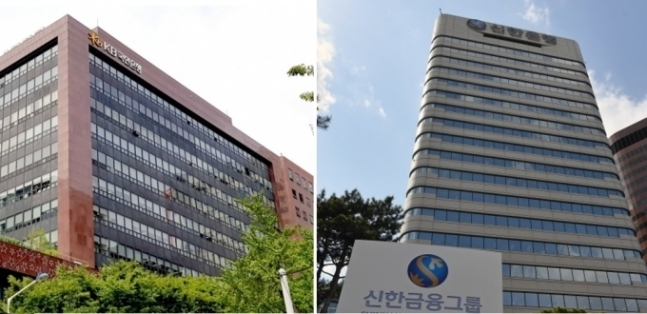Earnings
Korean banks log record profits on rising interest rates
Net interest margins are expected to rise further on policy interest rate hikes; Q4 profits may fall on higher costs, debt market woes
By Oct 25, 2022 (Gmt+09:00)
3
Min read
Most Read
LG Chem to sell water filter business to Glenwood PE for $692 million


Kyobo Life poised to buy Japan’s SBI Group-owned savings bank


KT&G eyes overseas M&A after rejecting activist fund's offer


StockX in merger talks with Naver’s online reseller Kream


Mirae Asset to be named Korea Post’s core real estate fund operator



South Korea’s major financial groups enjoyed record quarterly earnings as higher policy interest rates increased lending rates, powering the profits of their banks.
The country’s four-largest financial holding companies – KB Financial Group, Shinhan Financial Group, Hana Financial Group and Woori Financial Group – reported a combined net profit of 4.9 trillion won ($3.4 billion) in the third quarter, up 18.6% from a year earlier, according to their earnings statements on Tuesday.
Banks of those groups reported total interest income of 8.4 trillion won during the July-September period, offsetting losses from non-bank affiliates such as brokerage houses and insurers. The boom, however, came as rising borrowing costs added to the financial burden on households with debts and deteriorated corporate profitability, some critics pointed out.
Kookmin Bank, the country’s top lender, and Shinhan Bank said their interest incomes rose 22.5% and 28.1% to 2.4 trillion won and 2.1 trillion won on-year, respectively. KEB Hana Bank and Woori Bank also reported interest incomes of 2 trillion won and 1.9 trillion won, respectively.
RISING NET INTEREST RATE MARGIN
Interest rates on outstanding bank loans rose 0.8 percentage points on average in the first half of this year from the second half of 2021, while rates on deposits grew 0.52 percentage points, according to central bank data.
Local banks’ average net interest margin (NIM), a key indicator for profit, has been steadily increasing. Kookmin Bank’s NIM -- the difference between interest paid and interest received -- for example, rose to 1.72% by the third quarter of this year from 1.57% a year earlier. Such a rise in NIMs helped those four banks together report interest income of 23.8 trillion won in the first three quarters of this year.
Their interest incomes are likely to rise more as the central bank is expected to further raise the base interest rate, which is currently at 3.00%.
“Policy interest rate hikes will improve the NIM by 0.1 percentage points in the first quarter of next year,” said Shinhan Bank Chief Financial Officer Jung Sang-Hyuk.
SHINHAN TO BEAT KB
Shinhan Financial Group reported a third-quarter net profit of 1.6 trillion won including profit of 443.8 billion from its sale of Shinhan Investment Corp.'s headquarters in Seoul. The group’s net profit during the first three quarters totaled 4.3 trillion won, exceeding the profit of the country’s top KB Financial Group by 287.5 billion won during the period.
Shinhan Financial Group is likely to become the first financial holding company with an annual profit of 5 trillion won this year.
KB Financial Group’s third-quarter net profit eased 2.1% to 1.3 trillion won hurt by sluggish earnings from non-bank affiliates such as KB Securities Co. and KB Insurance Co. Kookmin Bank, on the other hand, reported a 6% rise in net profit to 824.2 billion won.
Hana Financial Group and Woori Financial Group said their net profits jumped 20.8% and 15.6% to 1.1 trillion won and 899.8 billion won, respectively.
DOUBLE-EDGED SWORD OF HIGHER INTEREST RATES
Profits of the four major financial groups in the fourth quarter may fall short of the third as rising interest rates also boosted their fundraising costs.
The outstanding term deposits with annual interest rates of 3-4% per annum at the four banks rose some 50 trillion won in the third quarter, while their demand deposits with average rates of 0.1% declined by more than 20 trillion won.
The recent liquidity problems in the local bond market may cause those banks to increase provisions for bad debts if the issue ramps up the delinquency rates of corporate loans.
Write to Bo-Hyung Kim and So-Hyun Lee at kph21c@hankyung.com
Jongwoo Cheon edited this article.
More to Read
-
 Corporate bondsKorea's $35 bn plan yet to ease Legoland default woes
Corporate bondsKorea's $35 bn plan yet to ease Legoland default woesOct 25, 2022 (Gmt+09:00)
4 Min read -
 Central bankBOK takes another big step hike as weak won lifts prices
Central bankBOK takes another big step hike as weak won lifts pricesOct 12, 2022 (Gmt+09:00)
3 Min read -

Comment 0
LOG IN


